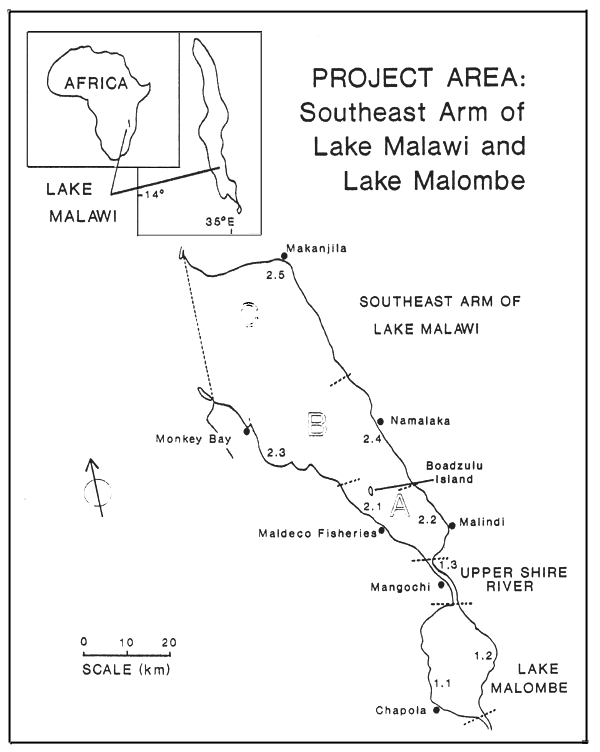
A report prepared by the GOM/FAO/UNDP Chambo Fisheries Research Project
MALAWI
 | Mechanised Fisheries of Lake Malawi |
FI:DP/MLW/86/013, Field Document 23, July 1992
by
G.F. Turner
For biblographic purposes this document should be cited as follows:
Turner, G.F. 1992 Mechanised fisheries of Lake Malawi. GOM/UNDP/FAO Chambo Fisheries Research Project, Malawi. FI:DP/MLW/86/013, Field Document 23: 22p.
This report was prepared during the course of the Chambo Fisheries Research project. The conclusions and recommendations given in the report are those considered appropriate at the time of its preparation.
The designations employed and the presentation of the material in this document do not imply the expression of any opinion whatsoever on the part of the Food and Agriculture Organization of the United Nations concerning the legal or constitutional status of any country or sea area, or concerning the delimination of frontiers.
FOOD AND AGRICULTURE ORGANISATION OF THE UNITED NATIONS
Monkey Bay, Malawi, July 1992
Hyperlinks to non-FAO Internet sites do not imply any official endorsement of or responsibility for the opinions, ideas, data or products presented at these locations, or guarantee the validity of the information provided. The sole purpose of links to non-FAO sites is to indicate further information available on related topics.
This electronic document has been scanned using optical character recognition (OCR) software. FAO declines all responsibility for any discrepancies that may exist between the present document and its original printed version.
Mechanised Fisheries of Lake Malawi
2. PRESENT MANAGEMENT STRATEGY
3. SPECIES COMPOSITION ANALYSIS
4. GEOGRAPHICAL LIMITS OF STOCKS
LIST OF CHAMBO FISHERIES RESEARCH REPORTS
Species composition analysis was used to determine the relationships between the different mechanised fisheries and between these and other techniques. All chambo species were found to be heavily exploited by both mechanised and artisanal sectors, indicating that a single assessment of chambo fisheries is required for the south-east arm of Lake Malawi. The midwater trawl was found to catch, in addition to chambo, large quantities of small pelagic haplochromine cichlids. The bottom trawl and pair trawl fisheries were found to be largely dependent on two separate communities of demersal haplochromine cichlids. Thus, all three major trawling techniques can be assessed separately. The topography of the various commercial fishing license areas is considered, and it is concluded that for the purposes of stock assessment that four areas be considered as independent units: Area A, Areas B & C, Areas D, E, & F and Area G.
The midwater trawl haplochromine fishery is estimated to be fully exploited in the south-east arm. The bottom trawl fishery in the south-east arm has been overexploited since 1983 and is presently yielding less than half of its potential. It was found that pair trawl fisheries did not show significant relationships between catch and effort, and it was not possible to estimate the maximum sustainable yields or optimum fishing levels. Possible explanations are discussed. The pair trawl fishery in Area A is presently showing signs of dangerous instability.

Map showing the project's working area and statistical divisions (minor strata).